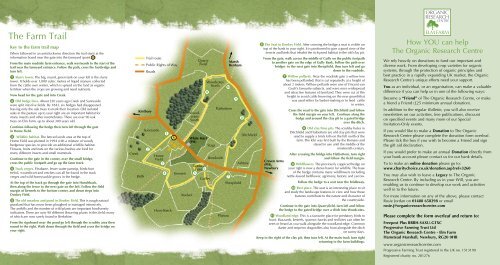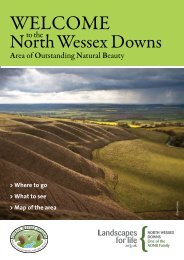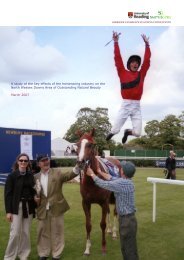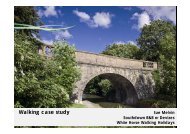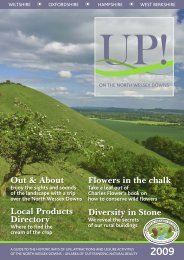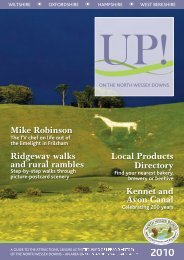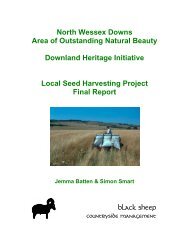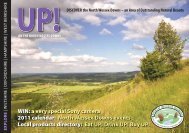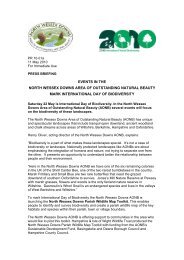The Organic Farm Trail at Elm Farm - North Wessex Downs Area of ...
The Organic Farm Trail at Elm Farm - North Wessex Downs Area of ...
The Organic Farm Trail at Elm Farm - North Wessex Downs Area of ...
You also want an ePaper? Increase the reach of your titles
YUMPU automatically turns print PDFs into web optimized ePapers that Google loves.
<strong>The</strong> <strong>Farm</strong> <strong>Trail</strong>Key to the farm trail mapWhen followed in an anticlockwise direction the trail starts <strong>at</strong> theinform<strong>at</strong>ion board near the g<strong>at</strong>e into the farmyard (point S )From the main roadside farm entrance, walk westwards to the start <strong>of</strong> thetrail near the farmyard entrance. Follow the p<strong>at</strong>h, cross the footbridge andturn left.A Slurry tower. <strong>The</strong> big, round, green tank on your left is the slurrytower. It holds over 1,000 cubic metres <strong>of</strong> liquid manure collectedfrom the c<strong>at</strong>tle over winter, which is spread on the land as organicfertiliser when the crops are growing and need nutrients.Now head for the g<strong>at</strong>e and into Creek.B Old hedge lines. About 220 years ago Creek and Sunnysidewere split into five fields. By 1843, six hedges had disappearedleaving only the oak trees to mark their loc<strong>at</strong>ion. Old isol<strong>at</strong>edoaks in the pasture up to your right are an important habit<strong>at</strong> formany insects and other invertebr<strong>at</strong>es. <strong>The</strong>re are over 90 oaktrees on <strong>Elm</strong> <strong>Farm</strong>, up to about 300 years old.Continue following the hedge then turn left through the g<strong>at</strong>ein Home Field.C Wildlife habit<strong>at</strong>. <strong>The</strong> fenced scrub area <strong>at</strong> the top <strong>of</strong>Home Field was planted in 1994 with a mixture <strong>of</strong> woodyhedgerow species, to provide an additional wildlife habit<strong>at</strong>.Flowers, fruits and nuts on the various bushes are food formany different insects and small mammals.Continue to the g<strong>at</strong>e in the corner, over the small bridge,cross the public footp<strong>at</strong>h and go up the farm track.D Track verges. Fleabane, lesser w<strong>at</strong>er parsnip, birds-foottrefoil, woundwort and vetches can all be found in the trackverges and wild honeysuckle grows in the hedge.At the top <strong>of</strong> the track go through the g<strong>at</strong>e into Hunchback,then along the fence to the next g<strong>at</strong>e on the left. Follow the fieldmargin <strong>of</strong> Kennels to the bottom corner, and down steps intoDonkey Field.E <strong>The</strong> old meadow and pond in Donkey Field. This is rough n<strong>at</strong>uralgrassland th<strong>at</strong> has never been ploughed or managed intensively.<strong>The</strong> anthills and the number <strong>of</strong> wild plants are important biodiversityindic<strong>at</strong>ors. <strong>The</strong>re are over 90 different flowering plants in this field; many<strong>of</strong> which are now rarely found in Berkshire.From the signboard near the pond go left through the scrubby area thenround to the right. Walk down through the field and cross the bridge onyour right.CreekKintburyBriffs<strong>Trail</strong> routePublic Rights <strong>of</strong> WayRoadsSunnyside2HomeField341HunchbackSKennelsRockerWoodcotesSouthQuarryFieldWhite Hart(PH)DonkeyField 65GulleyWoodcotes<strong>North</strong>11StagsBrooksideFl<strong>at</strong>bottomPl<strong>at</strong>eauMarshBenham1079Sheepfield8DitchfieldAshtreeF <strong>The</strong> Se<strong>at</strong> in Donkey Field. After crossing the bridge a se<strong>at</strong> is visible ontop <strong>of</strong> the bank to your right. It is positioned to give a good view <strong>of</strong> theinsects and birds th<strong>at</strong> inhabit the rich pond habit<strong>at</strong> in the old clay pit.From the g<strong>at</strong>e, walk across the middle <strong>of</strong> Gully on the public footp<strong>at</strong>hto another g<strong>at</strong>e on the edge <strong>of</strong> Gully Bank. Follow the p<strong>at</strong>h overbridges to the next g<strong>at</strong>e into Sheepfield, then turn left and godown to the roadside.G Willow pollards. Near the roadside g<strong>at</strong>e a willow treehas been pollarded; th<strong>at</strong> is cut repe<strong>at</strong>edly <strong>at</strong> a height <strong>of</strong>about 2 metres. Willow pollards were one <strong>of</strong> Vincent vanGoch’s favourite subjects, and were once widespreadand <strong>at</strong>tractive fe<strong>at</strong>ures <strong>of</strong> farmland. <strong>The</strong>y were cut <strong>at</strong> thisheight to avoid c<strong>at</strong>tle browsing on the new growthth<strong>at</strong>was used either for basket-making or to feed c<strong>at</strong>tlein winter.Cross the road to the g<strong>at</strong>e into Ditchfield and followthe field margin on your left. Continue along thehedge and around the clay pit to a g<strong>at</strong>ed bridgeover the ditch.H Old clay/lime pits. <strong>The</strong> scrubby holes inDitchfield and Fl<strong>at</strong>bottom are old clay pits th<strong>at</strong> wereused to supply a brick kiln on the hill north <strong>of</strong> thefarm. <strong>The</strong> kiln was first built by the Romans andstayed in use until the middle <strong>of</strong> thenineteenth century.Craven Arms(PH),NewburyAfter crossing the bridge into Fl<strong>at</strong>bottom, turn rightand follow the field margin.I Wildflowers. <strong>The</strong> previously coppiced hedge onyour right is now a dense haven for wildlife. <strong>The</strong> base<strong>of</strong> the hedge contains many wildflowers includingnettle-leaved bellflower, agrimony, betony and yarrow.Follow the hedge to a se<strong>at</strong> near the bridleway.J Rest place. <strong>The</strong> se<strong>at</strong> is an interesting place to sitand study the landscape fe<strong>at</strong>ures in view and how thesefe<strong>at</strong>ures contribute to the n<strong>at</strong>ure and character <strong>of</strong>the countryside.Continue to the g<strong>at</strong>e into Quarryfield, turn left and followthe hedge to the g<strong>at</strong>ed bridge over a ditch into Woodcotes.K Woodland edge. This is a favourite place for pred<strong>at</strong>ory birds tohunt. Buzzards, kestrels, sparrow hawks and red kites can <strong>of</strong>ten beseen or heard as you walk alongside the woodland edge. Commondarter and emperor dragonflies also hunt alongside the ditchon sunny days.Keep to the right <strong>of</strong> the clay pit, then turn left. At the main track turn rightreturning to the farm buildings.How YOU can help<strong>The</strong> <strong>Organic</strong> Research CentreWe rely heavily on don<strong>at</strong>ions to fund our important anddiverse work. From developing crop varieties for organicsystems, through the protection <strong>of</strong> organic principles andbest practice in a rapidly expanding UK market, the <strong>Organic</strong>Research Centre's unique efforts need your support.You as an individual, or an organis<strong>at</strong>ion, can make a valuabledifference if you can help us in one <strong>of</strong> the following ways:Become a “Friend” <strong>of</strong> <strong>The</strong> <strong>Organic</strong> Research Centre, or makea friend a Friend (£25 minimum annual don<strong>at</strong>ion).In addition to the regular Bulletin, you will also receivenewsletters on our activities, free public<strong>at</strong>ions, discounton specified events and many more <strong>of</strong> our SpecialInvit<strong>at</strong>ion-Only events.If you would like to make a Don<strong>at</strong>ion to <strong>The</strong> <strong>Organic</strong>Research Centre please complete the don<strong>at</strong>ion form overleaf.Please tick the box if you wish to become a Friend and signthe gift aid declar<strong>at</strong>ion.If you would prefer to make an annual Don<strong>at</strong>ion directly fromyour bank account please contact us for our bank details.To to make an online don<strong>at</strong>ion please go to:www.charitychoice.co.uk/don<strong>at</strong>ion.asp?ref=3260You may also wish to leave a Legacy to <strong>The</strong> <strong>Organic</strong>Research Centre. By including us in your Will, you areenabling us to continue to develop our work and activitieswell in to the future.For more inform<strong>at</strong>ion on any <strong>of</strong> the above, please contactRosie Jordan on 01488 658298 or emailrosie.j@organicresearchcentre.comPlease complete the form overleaf and return to:Freepost Plus RRRH-SAXU-GTXCProgressive <strong>Farm</strong>ing Trust Ltd<strong>The</strong> <strong>Organic</strong> Research Centre - <strong>Elm</strong> <strong>Farm</strong>Hamstead Marshall, Newbury, RG20 0HRwww.organicresearchcentre.comProgressive <strong>Farm</strong>ing Trust registered in the UK no. 1513190Registered charity no. 281276


